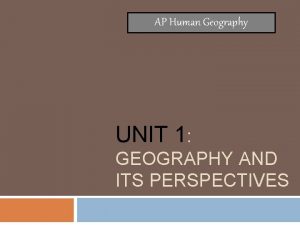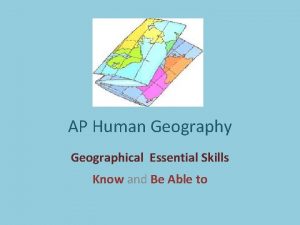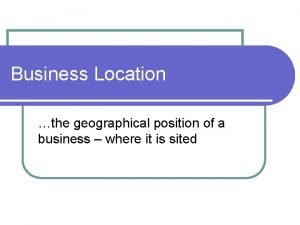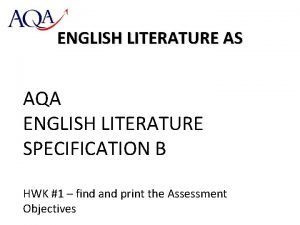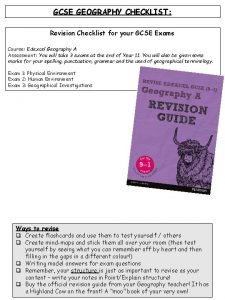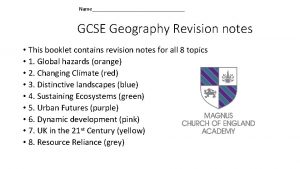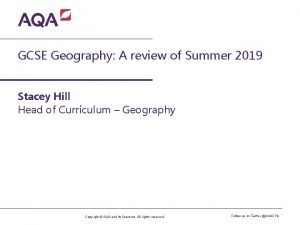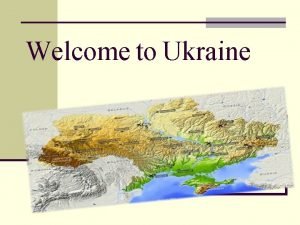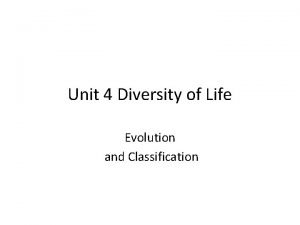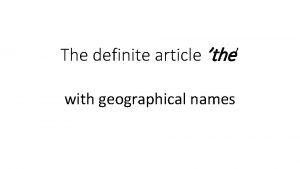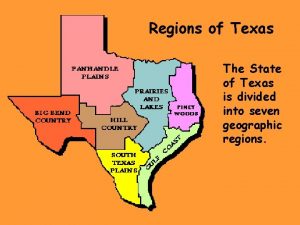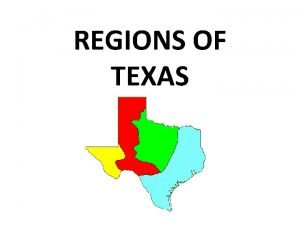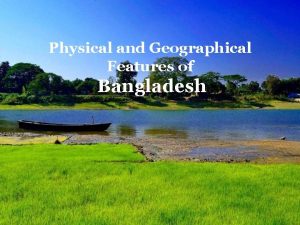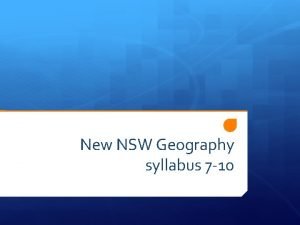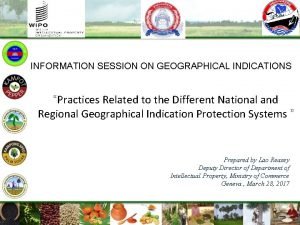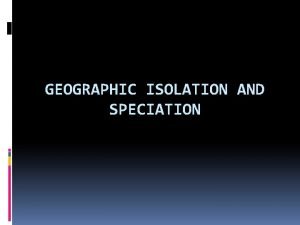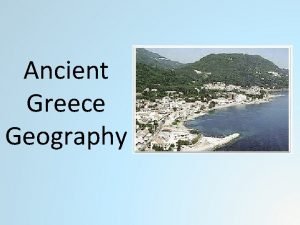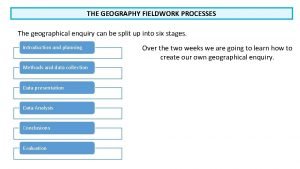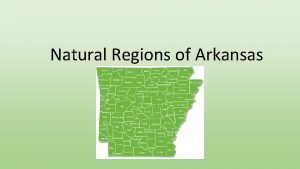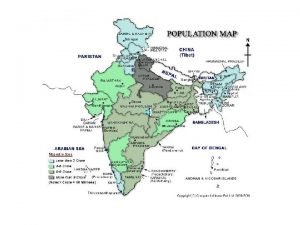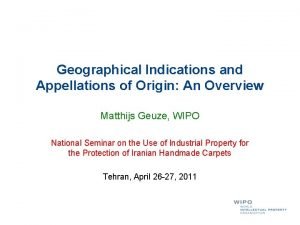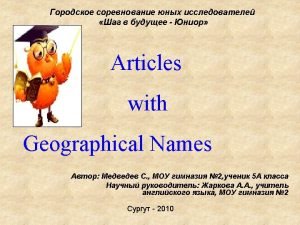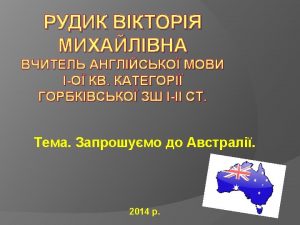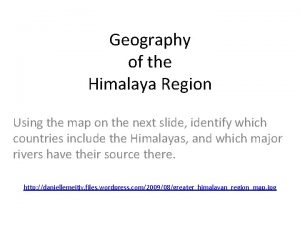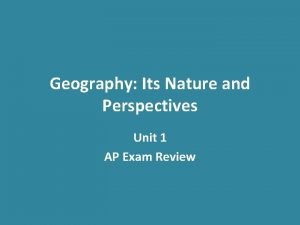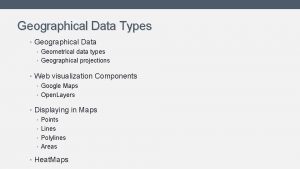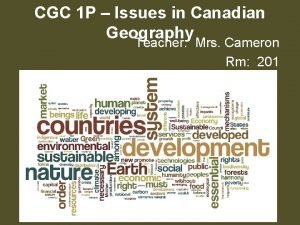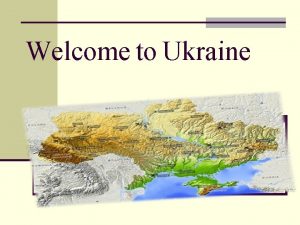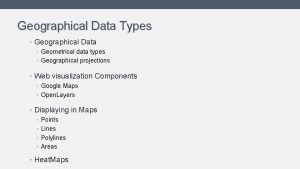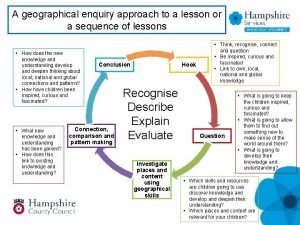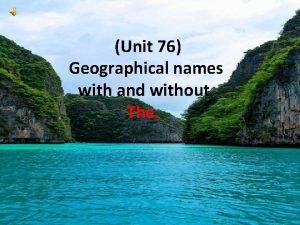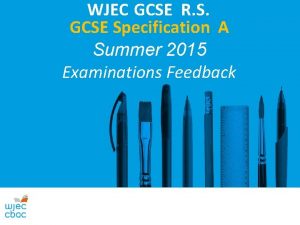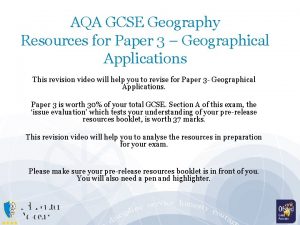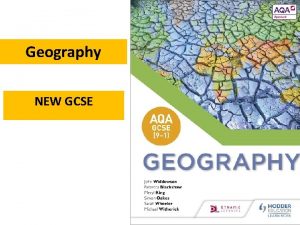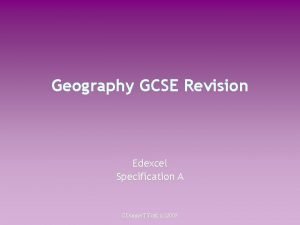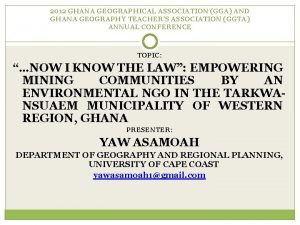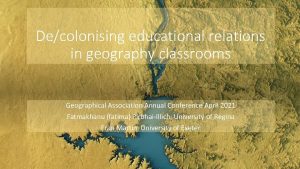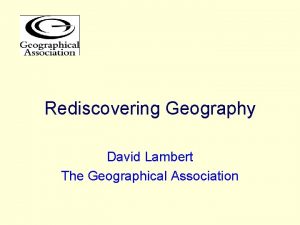GCSE Geography Geographical Association conference New specification Aims

























































- Slides: 57

GCSE Geography Geographical Association conference New specification: Aims, structure and distinctive features Copyright © AQA and its licensors. All rights reserved. Follow us on Twitter @AQACPD.

Structure 1. What are the new requirements for GCSE Geography? 2. What is the AQA approach? 3. What are some of the important features of each unit in the new GCSE Geography? 4. What do the new examination papers look like? 5. What are the practical benefits of the new specification? 6. How can you plan to teach the new GCSE Geography? 7. How will AQA support you teaching the new specification? Copyright © AQA and its licensors. All rights reserved.

Essential features of any new specification Geography of the UK –to include: Physical and human landscapes Environmental challenges Changing economy and society Importance of cultural and political factors Relationships with the wider world Physical geography Geomorphic processes and landscape Changing weather and climate People and environment Global ecosystems and biodiversity Resources and their management Human geography Cities and urban society Global economic development issues Fieldwork Synoptic element Copyright © AQA and its licensors. All rights reserved.

Key features of the new AQA specification • Balanced understanding of physical, human and environmental geography. • Thematic approach to the subject, with an emphasis on contemporary issues and future changes. • Flexibility: centres are free to choose their own exemplars and case study material. • Choice of optional content in selected themes, including landscapes, ecosystems and use of resources. • An issues evaluation and decision making exercise, contributing a problem solving element to assessment. • Freedom to choose any aspect of the specification when developing fieldwork programme. • An assessment structure that is manageable and realistic, with 3 papers totaling 4 hours 15 minutes. Copyright © AQA and its licensors. All rights reserved.

Overview of specification content 1. Living with the physical environment 2. Challenges in the human environment 3. Geographical applications Challenge of natural hazards: Urban challenges: Tectonic hazards, tropical Global patterns, two contrasting storms, extreme weather in the cities, sustainable urban futures UK, climate change Issue evaluation: Theme of issue can be selected from any compulsory part of the specification. Based on secondary sources The living world: Local ecosystems, tropical rainforests, one from hot deserts and cold environments The changing economic world: Global patterns, closing the development gap, contrasting studies of economic development Fieldwork: Two fieldwork enquiries, contrasting environments, physical and human geography, enquiry process. Physical landscapes in the UK: Two from coastal, river, glacial landscapes The challenge of resource management: Overview of resources in the UK, global resource securityone from food, water, energy Copyright © AQA and its licensors. All rights reserved.

Content and skills for Paper/Unit 1 Living with the physical environment • Natural hazards - involves the study of tectonic hazards, weather hazards and climate change. Note that there is only one case study of tectonic hazards and that the content is much reduced compared with existing specifications. Climate change focuses on causes and management (mitigation and adaptation). • The living world - focuses on the characteristics of ecosystems at different scales and threats to biodiversity. There is compulsory study of a local ecosystem and tropical rainforests, then a choice between hot deserts and cold environments. • Physical landscapes in the UK - involves the study of 2 different landscapes, the processes of erosion and deposition, and the landforms which result. Human intervention and management of the landscapes are considered. Again the content for each individual landscape is reduced compared with existing courses. Copyright © AQA and its licensors. All rights reserved.

Content and skills for Paper/Unit 2 Challenges in the Human Environment • Urban issues and challenges. Involves the study of global trends and patterns, the impacts of rapid urbanisation and the resulting opportunities and challenges in two contrasting cities. Includes sustainable methods of managing urban living. Detailed study of a UK city and one in a LIC/NEE. • The changing economic world. Looks at the complexities of measuring development and ways of reducing the development gap. Issues of trading relationships, international aid and the role of TNCs are explored. Detailed study of one named LIC or NEE and a contrasting study of economic futures in the UK and the place of the UK in the wider world • The challenges of resource management. Studies the increasing global demand for resources, highlighting stark inequalities. Issues of resource provision in the UK. Resource security in relation to either food, or water or energy-reasons for insecurity, impacts, strategies to increase supply including sustainable solutions. Copyright © AQA and its licensors. All rights reserved.

Underlying principles AQA’s approach to the new demands Continuity • To preserve some of the content of existing units, including some of the most popular. • To allow for some flexibility in choice of content within the constraints of the new subject criteria. • To retain those elements teachers value eg framework of key ideas and spec content, clear and manageable case study. requirement, standardised mark schemes, thematic approach to the subject, contemporary subject content, investigative approach to fieldwork. Copyright © AQA and its licensors. All rights reserved. Change • Specific focus on the geography of the UK. • Some previously less familiar themes and content will be taught and assessed. Some themes in current specifications will not be included. • Case studies will need to studied in full national and regional context. • Much of specification will be compulsory. Less scope for optionality compared with existing specifications. • Fieldwork will be assessed in the written examination.

Overlap with existing AQA Specifications New GCSE Specification A Specification B Challenge of Natural Hazards Restless Earth (partial), Challenge of Weather and Climate (partial) Living with Natural Hazards (partial) The Living World Challenge of Extreme Environments (partial) Physical landscapes in the UK Water on the Land, Coastal Zone, Ice on the Land (partial) The Coastal Environment Urban Issues and Challenges Changing Urban Environments The Urban Environment The Changing Economic World The Development Gap, Globalisation (partial), aspects of Population Change and Tourism Investigating the Globalisation of Industry The Challenge of Resource Management Aspects of Changing Rural Environments, Globalisation, Water on the Land Energy in the 21 st century, Water – a precious resource (partial) Copyright © AQA and its licensors. All rights reserved.

Case studies and examples Living with the physical environment The challenge of natural Hazards 1. 2. 3. The living world 1. 2. 3. Tectonic hazard-two contrasting countries-effects and responses (Ex) Tropical storm-effects and responses (Ex) Recent extreme weather event in UK-causes, impacts, management (Ex) Small scale UK ecosystem (Ex) Tropical rainforest-causes of deforestation, impacts and issues (CS) Hot desert or cold environment: development opportunities and challenges (CS) Physical 1. Section of coastline, river valley, glaciated arealandscapes in the landforms of erosion and deposition (Ex) United Kingdom 2. Coastal management scheme (Ex) or 3. Flood management scheme (rivers) (Ex) or 4. Tourism impacts and management (glaciated area) (Ex) 2 case studies and 8 examples required Copyright © AQA and its licensors. All rights reserved.

Case studies and examples: Challenges in the human environment 1. Urban issues and challenges 2. Major city in a LIC or NEE*-causes of growth, opportunities, challenges: social, economic, environmental (CS) urban planning (Ex) Major city in the UK-importance, migration, opportunities, challenges (CS) urban regeneration (Ex) The changing economic world 1. 2. 3. Growth of tourism in one LIC or NEE (Ex) One LIC or NEE-economic structure, TNCs, trade, aid, debt (CS) UK economic futures (CS) Industrial sustainability (Ex) The challenge of resource management 1. 2. or 1. 2. Large scale agricultural development (Ex) Local scheme to increase sustainable food supplies (Ex) Large scale water transfer scheme (Ex) Local scheme to increase water supply (Ex) Non renewable energy source (Ex) Local renewable energy scheme (Ex) *LIC=Lower Income Country, NEE-Newly Emerging Economy 3 case studies and 6 examples required Copyright © AQA and its licensors. All rights reserved.

Geography of the UK The geography of the UK is integrated into the physical and human geography themes studied: • The challenge of natural hazards-extreme weather in the UK. • Physical landscapes in the United Kingdom-coastal landscapes, river. landscapes, glacial landscapes. • The living world- small scale local ecosystem. • Urban issues and challenges-major city in the UK. • Changing economic world- economic futures in the UK. • Challenge of resource management-overview of food, water and energy resources in the UK. Copyright © AQA and its licensors. All rights reserved.

Specification/Assessment at a glance Unit 1: Living with the physical environment 35 % Unit 2: challenges in the human environment 35 % Unit 3: geographical applications 30 % The study of physical processes and patterns. Assessment: 1 hour 30 minutes 88 marks, including 3 SPAG The study of human geography themes and issues. Assessment: 1 hour 30 minutes 88 marks including 3 SPAG Issue evaluation, based on resource booklet, and fieldwork. Assessment: 1 hour 15 minutes Candidates answer all questions. 76 marks, including 6 SPAG Assessment of fieldwork represents 15% of total assessment. Assessment of maths and statistical skills must be 10% of total assessment Total marks 240 (plus 12 SPAG-5% of total) Copyright © AQA and its licensors. All rights reserved.

New assessment objectives AO Requirement weighting AO 1 Demonstrate knowledge of locations, places, processes, 15% AO 2 Demonstrate geographical understanding of: 25% AO 3 Apply knowledge and understanding to interpret, analyse 35% AO 4 Select, adapt and use a variety of skills and techniques to 25% environments and different scales. 2. 1 concepts and how they are used in relation to places, environments and processes; 2. 2 the inter-relationships between places, environments and processes. and evaluate geographical information and issues and to make judgements. investigate questions and issues and communicate findings. Copyright © AQA and its licensors. All rights reserved.

Command words-mark tariffs (SAMs) Command words 1 2 Identify/state/name/give * Define * Calculate * * Label * * 4 Draw * Outline * Compare * * Describe * * Explain Suggest * 6 * * Assess To what extent * * Evaluate Discuss Justify Copyright © AQA and its licensors. All rights reserved. 9 * * *

Paper/Unit 1 Copyright © AQA and its licensors. All rights reserved.

Summary of assessment • Unit 1 – Living with the physical environment 35% of the assessment 1 hour 30 minutes Candidates answer questions on: • The challenge of natural hazards - tectonic hazards, tropical storms, extreme weather in the UK, climate change. (30 marks +3 SPAG) • The living world - ecosystems, tropical rainforests, 2 from hot deserts and cold environments. (25 marks) • Physical landscapes in the United Kingdom - 2 from coastal landscapes, river landscapes, glacial landscapes. (30 marks) Question types in each section - multiple choice, short structured questions, cloze exercises, photo interpretation/description, interpretation of maps on different scales, data response, longer extended writing responses. Approximately 60% Levels marked questions. 4 mark questions are marked at 2 levels of response. 6 and 9 mark questions are marked at 3 levels of response. Copyright © AQA and its licensors. All rights reserved.

Point marked questions Mark scheme One mark for each correct answer: C Temperatures over most of the sea areas north of 60° N are expected to increase by 4 °C D Temperatures over the whole of Africa are likely to rise by 3 °C or 4 °C. No credit if three or more statements are shaded. AO 4 = 2 marks Copyright © AQA and its licensors. All rights reserved.

Point marked questions 05. 3 One mark for the correct answer: Glaslyn. AO 4 = 1 mark 05. 4 The answer requires application of knowledge and understanding to photographic evidence. Credit two separate points or a single developed reason, eg • rocks may be broken by frost shattering (1) • the rocks are well jointed, so may break up along lines of weakness as people walk on them (1) • water penetrates cracks during the day, then freezes and expands at night. This freeze-thaw process is repeated many times, causing the rocks to fracture (2). AO 3 = 2 marks Copyright © AQA and its licensors. All rights reserved.

Levels marked questions Copyright © AQA and its licensors. All rights reserved.

Levels marked questions Level 3 (Detailed) 5 -6 marks • AO 3 Demonstrates thorough application of knowledge and understanding to analyse geographical information, giving detailed explanation of formation of the features shown • AO 3 Makes full use analysis of the resource, using evidence to support response. Level 2 (Clear) 3 -4 marks • AO 1 Demonstrates specific and accurate knowledge of river processes and environments. • AO 2 Shows thorough geographical understanding of the interrelationships between river environments and processes. Level 1 (Basic) 1– 2 marks • AO 1 Demonstrates some knowledge of river processes and environments. • AO 2 Shows limited geographical understanding of the interrelationships between environments and processes. Copyright © AQA and its licensors. All rights reserved.

Levels marked questions Study Figure 5 a, a photograph showing an area affected by an earthquake in 2010, and Figure 5 b, a photograph showing an area affected by a volcanic eruption in 2006. Choose either an earthquake or a volcanic eruption. Assess the extent to which primary effects are more significant than secondary effects. Use Figure 5 a or 5 b and an example you have studied. [9 marks][+ 3 SPa. G marks] Mark scheme Level 3 (Detailed) 7– 9 marks • AO 1 Demonstrates detailed knowledge of the primary and secondary effects of a tectonic hazard on people and the environment. • AO 2 Shows thorough geographical understanding of the interrelationships between places, environments and processes in the context of a tectonic hazard. • AO 3 Demonstrates application of knowledge and understanding in a coherent and reasoned way in evaluating the relative significance of primary and secondary effects on people and the environment. Copyright © AQA and its licensors. All rights reserved.

Features of Paper 1 1. Familiar command words. Hierarchy of terms ranging from give/name/state/identify, complete, … to suggest, outline, compare, describe, explain, evaluate, to what extent, justify and discuss. 2. Wide mix of question types with mark tariffs ranging from 1 -9 marks aimed at all levels of ability. 3. Broad coverage of specification content eg Question 1 assesses aspects of climate change, extreme weather in the UK, tropical storms, tectonic hazards. 4. Clear emphasis on physical geography processes and features, but every question gives consideration to human interactions and/or responses. 5. Clear direction to use case study information in some extended writing questions. Potential to use case studies and examples elsewhere. 6. Wide range of stimulus materials - 19 Figures comprising photographs, OS maps, world maps, graphs, diagrams. All require some interpretation. No credit for direct lifts. Copyright © AQA and its licensors. All rights reserved.

Paper/Unit 2 Copyright © AQA and its licensors. All rights reserved.

Summary of assessment Unit 2: Challenges in the human environment 35% of the assessment Candidates answer questions on: • Urban issues and challenges (30 marks+ 3 SPAG) • The changing economic world (30 marks) • The challenge of resource management-general overview, one from food, water and energy. (25 marks) Question types in each section - multiple choice, short structured questions, closed exercises, photo interpretation/description, interpretation of maps on different scales, data response, longer extended writing responses. Copyright © AQA and its licensors. All rights reserved.

Paper 2 questions Copyright © AQA and its licensors. All rights reserved.

Paper 2 optional questions Copyright © AQA and its licensors. All rights reserved.

Insert heading Copyright © AQA and its licensors. All rights reserved.

Insert heading ‘Transnational corporations (TNCs) only bring advantages to the host country. ’ Do you agree with this statement? Yes……. No ……. . Justify your decision (9 marks) To what extent do urban areas in lower income countries (LICs) or newly emerging economies (NEEs) provide social and economic opportunities for people. [6 marks] Copyright © AQA and its licensors. All rights reserved.

Features of Paper 2 • Similar command words to Paper 1. • Mark tariffs range from 1 -9 marks aimed at all levels of ability. • Assessment covers topical issues such as fracking, water transfer problems, resource insecurity, Fairtrade, urban congestion management. • Several opportunities to use case study information in extended writing questions. 4 questions will require the use of examples/case studies. • Wide range of stimulus materials - 15 Figures comprising photographs, OS map, world/UK/Africa maps, graphs, table of statistics, diagrams. Copyright © AQA and its licensors. All rights reserved.

Paper/Unit 3 Copyright © AQA and its licensors. All rights reserved.

Summary of assessment Unit 3: Geographical applications 30% of the assessment Section A - Issue Evaluation Compulsory structured questions on a theme – leading up to an extended writing task based on a pre-release Sources Booklet – to be issued to students in advance. The theme will arise from the subject content of Units 1 or 2 but may extend beyond it through the use of the resources. The theme could combine human and physical aspects. (34 marks +3 SPAG) Section B - Fieldwork Compulsory questions based on candidates’ enquiry work and the use of fieldwork materials in an unfamiliar context. (36 marks +3 SPAG) Copyright © AQA and its licensors. All rights reserved.

Content and skills for Paper/Unit 3 Geographical applications Section A: Issue evaluation • Assessment is synoptic, requiring students to use their learning across the specification so they can analyse an issue, consider and select proposed solutions and justify choices. • The issue can be selected from any part of the core specification and can cover more than one topic. • A resource booklet will be sent to centres 12 weeks prior to the examination in June, so students can become familiar with the source materials. • A fresh copy of these materials will be issued at the start of the examination. Copyright © AQA and its licensors. All rights reserved.

Issue evaluation • Students learn about an issue, study options to solve it and make a decision. They consider the points of view of the stakeholders involved, make an appraisal of the advantages and disadvantages, and evaluate the alternatives. • Resource sheet will consist of a mix of geographical sources such as maps on different scales, photographs, satellite images, fact files, statistics, graphs, newspaper extracts, quotes from different interest groups. • Assessment will consist of a series of shorter questions related to the contemporary geographical issue, based on the interpretation of the resources. These lead to a more extended piece of writing (9 marks), involving a decision with some justification. Copyright © AQA and its licensors. All rights reserved.

Paper 3 Section A • Issue evaluation theme – Specimen = Development project in Kolkata (from Urban Issues and Challenges). Could be tropical rainforests, weather or tectonic hazards, climate change, development issues, energy resources etc. • Resource booklet (pre-release) - maps, tables of statistics, news cuttings, graphs, photos, background to the issue, quotes. • Sources provided in the examination – details of possible schemes. • Examination: series of short skills questions (2 -3 marks), and more extended writing questions based on sources (6 marks), leading to decision making exercise. (9 marks) • At least one question will be synoptic ie drawing on content from more than one theme. • Assessment Objectives targeted - mainly AO 3 and AO 4 - showing ability to apply knowledge and understanding in different contexts to analyse, interpret, evaluate and make judgements. Copyright © AQA and its licensors. All rights reserved.

Insert heading Three projects have been suggested to try and improve the quality of life for the urban poor in Kolkata. These are described in Figure 5. Which of the three projects do you think will improve the socio-economic and environmental conditions for the urban poor of Kolkata most effectively? Explain why you have reached this decision. (9 marks) Copyright © AQA and its licensors. All rights reserved.

Fieldwork • Students need to undertake two geographical enquiries, each of which must include the use of primary data, collected as part of a fieldwork exercise. • The two enquiries must be carried out in contrasting environments and show an understanding of both physical and human geography. • In at least one of the enquiries students are expected to show an understanding about the interaction between physical and human geography. Copyright © AQA and its licensors. All rights reserved.

Planning Effective planning in the classroom before carrying out fieldwork can make data collection efficient, saving a lot of time. Candidates must be very clear about how they will collect and record the data required before leaving the school. Copyright © AQA and its licensors. All rights reserved.

Contrasting environments will have to be visited for candidates to undertake the physical and human geography enquiries, but the locations need not be far apart. Looking at beach processes and then going into the seaside town nearby would satisfy all requirements. Investigating river processes and then carrying out an urban investigation nearby would also be appropriate. Planning to reduce travelling would maximise time for practical fieldwork. Copyright © AQA and its licensors. All rights reserved.

Fieldwork assessment Students’ understanding of the enquiry process will be assessed by: • Questions based on the use of fieldwork materials from an unfamiliar context. • Questions based on candidates’ individual enquiry work. (For these questions candidates will have to identify the titles of their individual enquiries). Written statement from centres, providing the date, location, numbers of students participating, the main issues/questions investigated during fieldwork, and the relationship of the fieldwork to the specification content There will no longer be Controlled Assessment in GCSE Geography Copyright © AQA and its licensors. All rights reserved.

Insert heading Assessment will include questions based on fieldwork materials from an unfamiliar context. Copyright © AQA and its licensors. All rights reserved.

Insert heading Copyright © AQA and its licensors. All rights reserved.

Physical geography fieldwork examples Topic Posed as a question Posed as a simple hypothesis River landscapes – cross How does the cross profile of the river X change? That the cross profile of the river X changes over distance. River landscapes – bedload How does the bedload of That the bedload of the river X change? river X will change over distance. Coastal landscapes – longshore drift In which direction is longshore drift operating along the coast at X? That longshore drift is from West-East at X. Coastal landscapes – mass movement How is mass movement affecting the coast at X? That mass movement is a major process affecting the coast at X. Copyright © AQA and its licensors. All rights reserved.

Human geography fieldwork examples Topic Posed as a question Posed as a simple hypothesis Tourism (in a glaciated area) What are the That tourism creates environmental impacts of environmental impacts at tourism at X? X. Urban change – opportunities What are the recreation opportunities in X? Urban change – challenges What impact is urban sprawl having on the rural-urban fringe? Economic futures in the UK What benefits have the science/business park at X brought to the local area? Copyright © AQA and its licensors. All rights reserved. That X provides a range of recreational opportunities for local people. That urban sprawl is having a negative impact on the rural-urban fringe. That the science/business park at X has brought a wide range of benefits to the local area.

Scale of the fieldwork With legacy coursework and the controlled assessment, the fieldwork component accounted for 25% of the GCSE qualification. This is now 15% and some of that total percentage must be assessed by presenting candidates with unfamiliar material. Copyright © AQA and its licensors. All rights reserved.

Fieldwork enquiry process Identifying suitable question for geographical enquiry Selecting, measuring and recording data appropriate to the chosen enquiry Selecting appropriate ways of processing and presenting fieldwork data Describing, analysing and explaining fieldwork data Reaching conclusions Evaluating the geographical enquiry Copyright © AQA and its licensors. All rights reserved.

Prompt/discussion questions Discussion/prompt questions that may be used in the field and when completing the work in class could include: • Explain how theory behind the investigation determined the data collection method(s) used. • How can we justify the sampling strategies employed? • Justify the choice of location(s) used to collect data. • Assess the appropriateness of your data collection methods. • Evaluate the effectiveness of your data collection methods. • Assess the appropriateness of your data presentation methods. • To what extent can the fieldwork results be deemed to be reliable? • Evaluate the accuracy and reliability of your results/conclusions. Copyright © AQA and its licensors. All rights reserved.

Sample fieldwork questions 1. State the title of your fieldwork enquiry in which physical geography data were collected. Title of fieldwork enquiry: …………… Explain the advantage(s) of the location(s) used for your fieldwork enquiry. (2 marks) 2. Justify one primary data collection method used in relation to the aim(s) of your physical geography enquiry. (3 marks) Primary data collection method: …………… 3. State the title of your fieldwork enquiry in which human geography data were collected……… Assess how effective your presentation technique(s) were in representing the data collected in this enquiry. (6 marks) Copyright © AQA and its licensors. All rights reserved.

Geographical skills Skills will be assessed in all three written exams. Ordnance Survey maps or other map extracts may be used in any of the three exams. Cartographic-atlas maps, OS maps, maps with photographs Graphical skillsselecting and constructing appropriate graphs, charts, maps Numerical skillsnumber, area, scale, proportion, ratio Statistical skillscentral tendency, spread, scatter plots Use and interpretation of qualitative and quantitative data from primary and secondary sources, including GIS Copyright © AQA and its licensors. All rights reserved.

The use of mathematics and statistics in Geography Statistical skills: • Measures of central tendency, spread and cumulative frequency (median, mean, range, quartiles and inter-quartile range, mode and modal class). • Calculate percentage increase or decrease and understand the use of percentiles. • Describe relationships in bivariate data: sketch trend lines through scatter plots, draw estimated lines of best fit, make predictions, interpolate and extrapolate trends. • Identify weaknesses in selective statistical presentation of data. Copyright © AQA and its licensors. All rights reserved.

Managing and planning the course Curriculum requirements • 6 themes (3 physical geography, 3 human geography). • Some have slightly more content than others: The Living World and Resource Management are shorter units. • Fieldwork planning, data collection and follow up. • Planning for Issue Evaluation. General skills and scrutiny of pre-release. • Geographical skills, including maths and statistics. Integrated or separate coverage? • Examination practice, revision. Copyright © AQA and its licensors. All rights reserved.

Planning the course • Choice of options eg 2 out of 3 physical landscapes in the UK; cold environment or hot deserts; food, water or energy? • Selection of suitable case studies, especially 2 contrasting cities (urban challenges) and the LIC/NEE (changing economic world). There are 5 case studies and 14 examples throughout the specification, which focus on the UK and other global examples of your choice. They allow for an in-depth study of physical and human environments. • Sequence of units/themes. • All physical, then human geography? (or vice versa) • Mixture of topics-physical, human, physical etc? • Separate coverage of UK themes, then more global issues? • Where does fieldwork fit in? • Available resources for teaching the course, particularly less familiar aspects eg UK geography, resource management, weather hazards. • Assessment objectives. Consider the implications of the assessment structure for planning and teaching, particularly the requirements of AO 3. Copyright © AQA and its licensors. All rights reserved.

Timings/curriculum structure AQA GCSE Geography Basic assumptions: 67 week course (Year 1: 38 weeks, Year 2: 29 weeks) Key Stage 4 contact time 2 x 1 hour per week Total teaching time: 134 hours (Df. E GLH -120 -140 hours) Copyright © AQA and its licensors. All rights reserved.

Two year course outline Separate physical and human topics Year 1 (Year 10) -3 8 weeks (76 hours) Unit 1: Living in the physical environment (28 weeks) + Fieldwork (5 weeks) + human environment (4 weeks) Year 10 Autumn Term (13 weeks) Spring term (11 weeks) Ecosystems (9 weeks) Physical landscapes of the UK (6 weeks) UK (4 weeks) Fieldwork – planning, preparation, visits and writeup (5 weeks) Summer term (14 weeks) Natural hazards (9 weeks) Exams (1 week) Urban issues and challenges (4 weeks) Year 2 (Year 11)- 29 weeks (58 hours) Unit 2 – Challenges in the human environment (24 weeks) + DME / Revision ( 6 weeks) Year 11 Autumn Term (13 weeks) Spring term (11 weeks) Summer term (6 weeks) Urban issues and challenges (continued) (6 weeks) Changing economic world (7 weeks) Changing economic world (contd. )( 4 weeks) Challenge of resource management (7 weeks) DME work post pre-release ( 3 weeks) Revision ( 3 weeks) Copyright © AQA and its licensors. All rights reserved.

Three year course outline Separate physical and human topics Year 9 Autumn Term (13 weeks) Spring term (11 weeks) Summer term (14 weeks) Natural hazards/Tectonic hazards (6 weeks) Tropical storms (4 weeks) Extreme weather in the UK (3 weeks) Climate change – Global and UK focus (4 weeks) Physical landscapes in UK (2 weeks) Coastal landscapes (5 weeks) Coastal landscapes (3 weeks) River or Glacial Landscapes (7 weeks) Fieldwork ( 3 weeks)- pilot study based on physical landscape. Exams (1 week) Autumn Term (13 weeks) Spring term (11 weeks) Summer term (14 weeks) Ecosystems (2 weeks) Tropical Rainforest (6 weeks) Hot deserts or Cold Environments (5 weeks) Urban issues and challenges (11 weeks) Fieldwork Investigations (5 weeks) Changing Economic world (9 weeks) Year 10 Year 11 Autumn Term (13 weeks) Spring term (11 weeks) Changing Economic world (5 Mock exams (2 weeks) Resource Management (4 weeks) Resource Management (8 weeks) Skills revision (3 weeks) DME work post pre-release (2 weeks) Copyright © AQA and its licensors. All rights reserved. Summer term (6 weeks) DME work post pre-release (2 weeks) Revision (4 weeks)

AQA ongoing support and resources • AQA website • e-AQA • Secure Key Materials • ERA (Enhanced Results Analysis) • Training courses • Preparing to teach events • AQA family of businesses (Exampro, Teach it, Alfie) Copyright © AQA and its licensors. All rights reserved.

Key features • Flexibility within topics allows centres to select specific content and learning experiences. • The course encourages a enquiry based approach to learning. • A decision making exercise based on pre-released sources. • No Controlled Assessment means there is more time for teaching, less administration and fewer logistical issues. Opportunities for fieldwork are highlighted and encouraged where relevant. • Specific guidance on the selection of fieldwork tasks will be provided • A variety of assessment techniques, ranging from short structured and stimulus/data response questions to extended writing mini essays. • Examination papers that are targeted at the full range of ability, with opportunities for higher ability candidates to be challenged. Copyright © AQA and its licensors. All rights reserved.
 Formal region example
Formal region example Essential skills to study geography
Essential skills to study geography Upper specification limit and lower specification limit
Upper specification limit and lower specification limit Upper specification limit and lower specification limit
Upper specification limit and lower specification limit Geographical position of a potential new business
Geographical position of a potential new business Edexcel gcse pe specification
Edexcel gcse pe specification Ocr gcse pe specification
Ocr gcse pe specification Aqa gcse english literature specification
Aqa gcse english literature specification Gcse geography case studies
Gcse geography case studies Aqa gcse geography revision checklist
Aqa gcse geography revision checklist Geography gcse revision notes
Geography gcse revision notes Aqa gcse geography
Aqa gcse geography Ccea gcse geography past papers
Ccea gcse geography past papers American school health association conference
American school health association conference Travel health insurance association annual conference
Travel health insurance association annual conference Doca defense
Doca defense Cairo conference definition ap human geography
Cairo conference definition ap human geography Geographical position of ukraine
Geographical position of ukraine What does a human embryo look like
What does a human embryo look like Registration process of geographical indication
Registration process of geographical indication Registration of geographical indication
Registration of geographical indication Physical features of the southeast region
Physical features of the southeast region Coastline paradox
Coastline paradox The with geographical names
The with geographical names Geographical influence on architecture
Geographical influence on architecture 7 regions of texas
7 regions of texas Texas geographic regions
Texas geographic regions Physical features of bangladesh
Physical features of bangladesh Geographical division structure
Geographical division structure Geography syllabus nsw
Geography syllabus nsw Registration process of geographical indication
Registration process of geographical indication Geographic isolation
Geographic isolation France geographical location
France geographical location Greece geography map
Greece geography map Nubia geography
Nubia geography Ethnic groups in the allegheny plateau
Ethnic groups in the allegheny plateau Geographical position of the usa
Geographical position of the usa What is geographical enquiry
What is geographical enquiry Form adjectives from the following geographical names
Form adjectives from the following geographical names Six regions of arkansas
Six regions of arkansas Geographical position has given india
Geographical position has given india Continents without names
Continents without names Indications and appellations of origin
Indications and appellations of origin Test articles with geographical names
Test articles with geographical names Australia geographical position
Australia geographical position Geographical forces
Geographical forces Geographical map of himalayas
Geographical map of himalayas What geographical feature usually distinguishes time zones?
What geographical feature usually distinguishes time zones? Great britain geographical position
Great britain geographical position Types of geographical data
Types of geographical data Geographic events
Geographic events England geographical position
England geographical position Luzon 1 provinces
Luzon 1 provinces Isodemographic map
Isodemographic map Geographical position of ukraine
Geographical position of ukraine Geographical data types
Geographical data types Geographical enquiry
Geographical enquiry Geographical names with and without the
Geographical names with and without the
